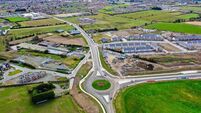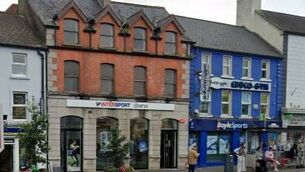Plan to return Kildare quarry to field within five years

The restoration works will comprise of the phased filling of almost 100,000m³ “of clean, inert imported topsoil”, according to the planning application
A Dublin firm has just applied to restore a worked out quarry in Kildare back to its agricultural origins, and expects a decision before the end of February.
The 4.17Ha (10.3ac) site is at Ardscull, about six kilometres from Athy on the main Naas Road (R418).
The restoration works will comprise of the phased filling of almost 100,000m³ “of clean, inert imported topsoil”, according to the planning application.
Although it doesn’t say whether this is imported from elsewhere in Kildare, or from abroad, Rossmore Civils – the Baldonnel-based firm tasked with the job – have said they will be seeking a waste facility permit in relation to the importation of this soil.
“The material is soil and stone,” clarified engineer Michael Dineen, on behalf of the landowner Noelle Wall from nearby Rosetown.
“It’s inert sub-soil and topsoil, engineered materials.
“The site is a bit of a moonscape, you can’t drive on it, put livestock on it, and has been for 20 plus years.
“It was for a Celtic Tiger project, and its reinstatement will be spread over five years, with probably 50 movements (truck journeys) a week.
“Rossmore have been at this for 20 years.
“There are no streams about the place so it’s a win-win for the landowner and the company.
“This is a very tangible example of the circular economy.
“There will be about 300mm of quality topsoil but the most stringent quality control will be from the landowners themselves.
“This is one of the most straightforward jobs I’ve seen – the farmer has the land, and the company has the materials.
“Rossmore Civils would handle up to 1m tonnes of this a year, so it is a daily occurrence for them."
Offering background in her letter to Kildare County Council in support of Rossmore Civil’s application, Ms Wall said: “Some years prior to my ownership, the field was completely stripped of topsoil, and it and significant quantities of subsoil and weathered rock was removed from the site.
“As a consequence, legacy issues persist at the field (such as) a highly irregular profile, with humps and hollows, voids and pits throughout.
“The existing surface of the field is now extremely hard with a mix of rock fragments and stones sticking up through the surface, and the natural drainage of the field has been negatively affected by this, leading to ponding.
“It is currently difficult to walk the field, and almost impossible to drive any vehicle or keep livestock, in the field.
“Other than weeds and scrub, nothing will grow in the field unless significant subsoil and topsoil restoration acts are undertaken."
Ms Wall is supported in her endeavours by Carlow-based agricultural consultant William Kelly who provides the professional justification for “the restoration of ground levels to improve agricultural productivity”.
“Levels in this site are all humps and hollows, which gives a profile not in harmony with adjoining lands,” he said.
“It needs to be raised up … (and) when finished with topsoil and properly drained and reseeded, this area will be more beneficial for agricultural production."
Mr Kelly recommends “a minimization of compaction” by mixing materials and working in dry conditions, and installing a surface layer of between 200-300mm of good quality topsoil.
He also recommends the inclusion of clover when reseeding to aid soil structure recovery.





